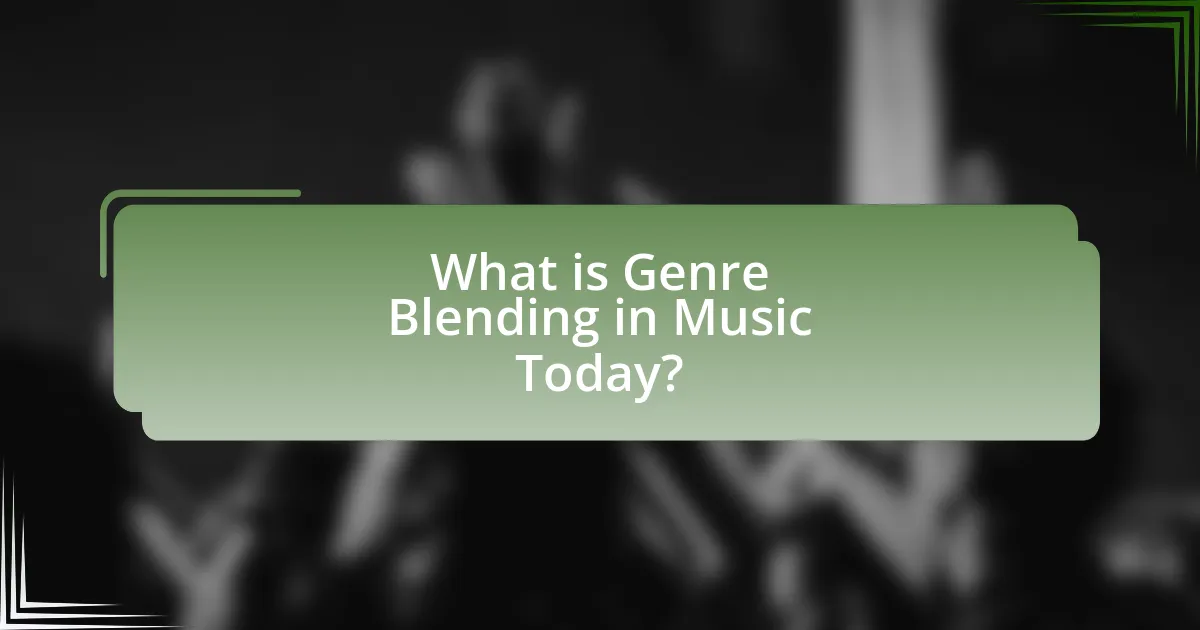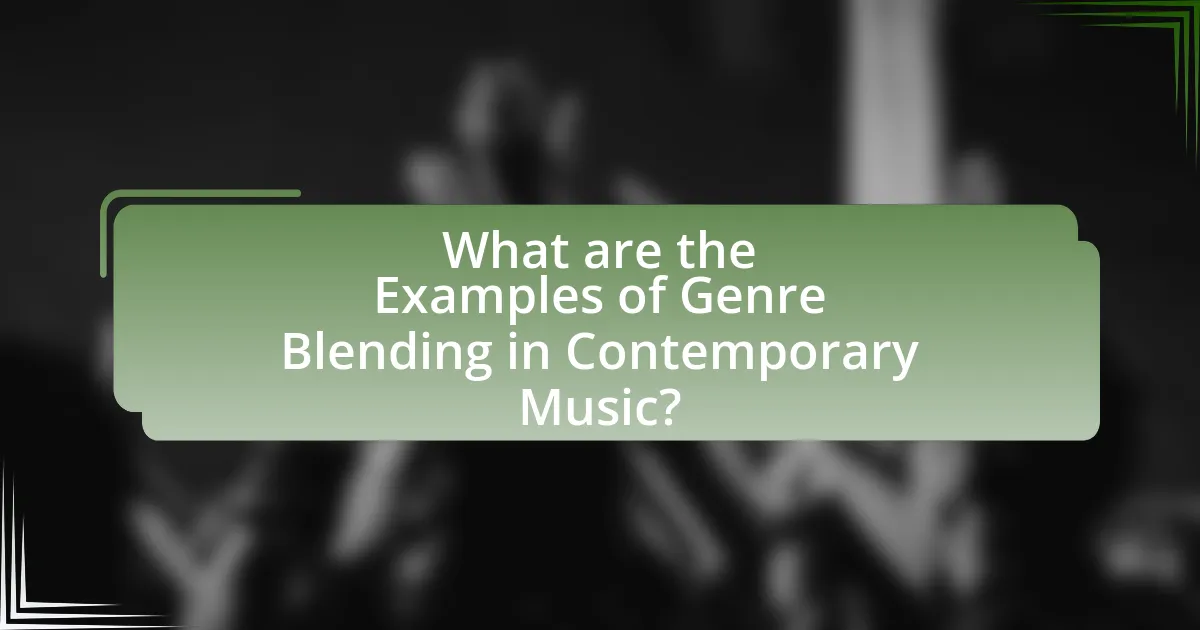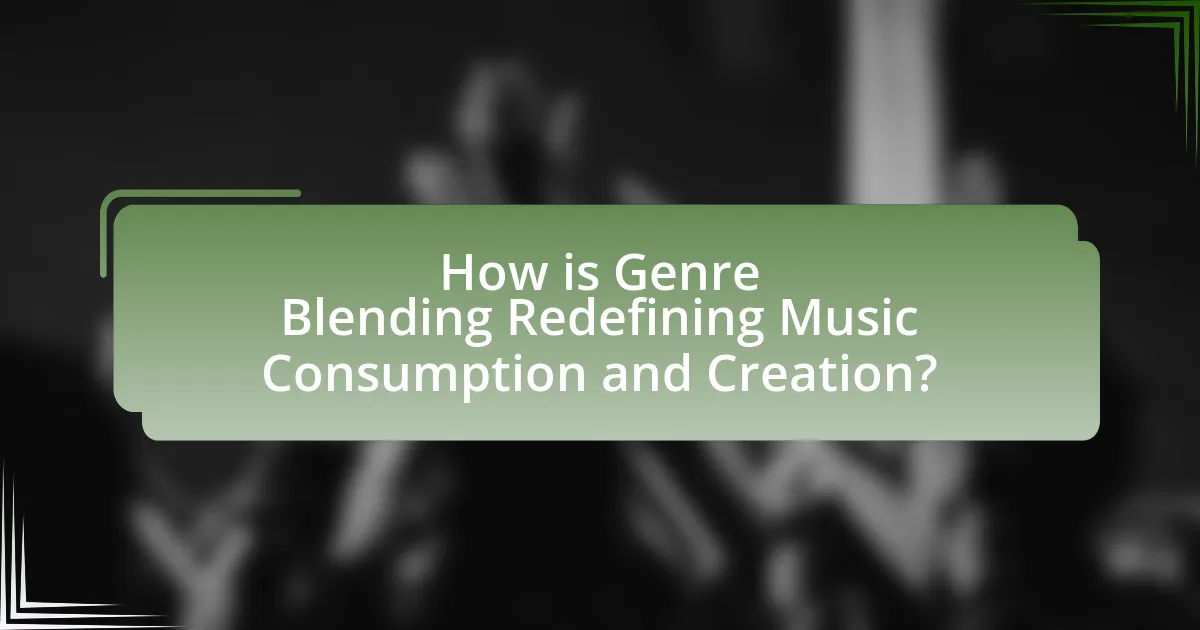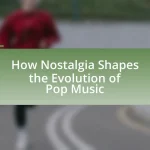Genre blending in music today involves the combination of elements from various musical genres to create innovative and hybrid sounds, significantly impacting the contemporary music landscape. This practice allows artists to challenge traditional boundaries, as seen in the success of tracks like Lil Nas X’s “Old Town Road,” which merges country and hip-hop. The article explores how genre blending differs from traditional music genres, its key characteristics, and the influence of technology and cultural shifts on this trend. It also examines notable artists leading the movement, the impact of genre blending on music consumption and creation, and the challenges faced by artists in navigating this evolving landscape.

What is Genre Blending in Music Today?
Genre blending in music today refers to the practice of combining elements from multiple musical genres to create innovative and hybrid sounds. This phenomenon has gained significant traction in the contemporary music landscape, as artists increasingly draw inspiration from diverse styles such as pop, hip-hop, rock, electronic, and world music. For instance, the rise of artists like Lil Nas X, who merges country and hip-hop in his hit “Old Town Road,” exemplifies how genre blending can challenge traditional boundaries and appeal to a broader audience. Additionally, data from the Recording Industry Association of America indicates that genre-blended tracks often achieve higher streaming numbers, reflecting their popularity and the evolving tastes of listeners.
How does genre blending differ from traditional music genres?
Genre blending differs from traditional music genres by combining elements from multiple genres to create a new, hybrid sound, rather than adhering strictly to the conventions of a single genre. Traditional music genres are characterized by specific stylistic features, instrumentation, and cultural contexts, which often limit the scope of creativity. In contrast, genre blending allows artists to experiment and innovate, resulting in unique musical expressions that can appeal to diverse audiences. For example, the rise of genres like country-rap or jazz-hop illustrates how artists merge distinct musical traditions, leading to new subgenres that challenge the boundaries of conventional classifications. This evolution reflects a broader trend in the music industry where collaboration and cross-genre experimentation are increasingly common, reshaping listeners’ expectations and experiences.
What are the key characteristics of genre blending?
Genre blending is characterized by the fusion of elements from multiple musical genres to create a new, hybrid sound. This approach often results in innovative compositions that defy traditional genre boundaries, allowing for greater artistic expression. Key characteristics include the incorporation of diverse musical styles, the use of varied instrumentation, and the blending of lyrical themes from different genres. For instance, the combination of hip-hop and country in songs like “Old Town Road” by Lil Nas X exemplifies how genre blending can reach wide audiences and challenge conventional music classifications. Additionally, genre blending often reflects cultural diversity and influences, showcasing the interconnectedness of musical traditions across different backgrounds.
How has technology influenced genre blending?
Technology has significantly influenced genre blending by providing artists with advanced tools for music production and distribution. Digital audio workstations (DAWs) enable seamless integration of various musical styles, allowing musicians to experiment with different genres without the constraints of traditional recording methods. For instance, the rise of software like Ableton Live and Pro Tools has facilitated the fusion of electronic, hip-hop, and rock elements, leading to innovative subgenres such as electronic rock and trap. Additionally, streaming platforms like Spotify and Apple Music promote genre-blending by using algorithms that recommend diverse music, encouraging listeners to explore and embrace hybrid styles. This accessibility and exposure have resulted in a more fluid music landscape where genre boundaries are increasingly blurred.
Why is genre blending significant in the current music landscape?
Genre blending is significant in the current music landscape because it fosters innovation and expands audience reach. By merging elements from different genres, artists create unique sounds that attract diverse listener demographics, enhancing their marketability. For instance, the rise of genres like country-rap, exemplified by artists such as Lil Nas X with “Old Town Road,” showcases how blending can lead to viral success and chart-topping hits. This trend reflects a broader cultural shift towards inclusivity and experimentation in music, allowing for greater artistic expression and collaboration across traditional genre boundaries.
What cultural shifts have contributed to the rise of genre blending?
Cultural shifts such as globalization, technological advancements, and the rise of digital platforms have significantly contributed to the rise of genre blending in music. Globalization has facilitated cross-cultural exchanges, allowing artists to draw influences from diverse musical traditions, leading to innovative hybrid genres. Technological advancements, particularly in music production and distribution, have enabled artists to experiment with different sounds and styles, breaking traditional genre boundaries. Additionally, digital platforms like streaming services have democratized music access, allowing listeners to explore and embrace a wider variety of genres, further encouraging artists to blend styles to reach broader audiences.
How does genre blending reflect societal changes?
Genre blending reflects societal changes by showcasing the increasing diversity and interconnectedness of cultural influences. As societies become more multicultural and globalized, music that combines elements from various genres, such as hip-hop with country or jazz with electronic, illustrates the breaking down of traditional barriers. This phenomenon is evidenced by the rise of artists like Lil Nas X, whose “Old Town Road” merges country and rap, achieving massive popularity and highlighting shifting listener preferences. Additionally, the blending of genres often addresses contemporary social issues, such as identity and belonging, further demonstrating how music evolves in response to societal dynamics.

What are the Examples of Genre Blending in Contemporary Music?
Examples of genre blending in contemporary music include the fusion of hip-hop and rock, as seen in collaborations like Linkin Park and Jay-Z’s “Collision Course,” which combines rap verses with rock instrumentation. Another example is the emergence of country-pop, exemplified by artists like Kacey Musgraves, who incorporates traditional country elements with pop sensibilities. Additionally, the genre known as reggaeton blends Latin rhythms with hip-hop and dancehall influences, prominently featured in tracks by artists like Bad Bunny. These instances illustrate how contemporary music continuously evolves by merging distinct genres, creating innovative sounds that appeal to diverse audiences.
Which artists are leading the genre blending movement?
Artists leading the genre blending movement include Billie Eilish, Lil Nas X, and Anderson .Paak. Billie Eilish combines pop, electronic, and indie influences, evident in her Grammy-winning album “When We All Fall Asleep, Where Do We Go?” which features diverse soundscapes. Lil Nas X gained fame for merging country and hip-hop in his hit “Old Town Road,” which topped the Billboard Hot 100 for a record-breaking 19 weeks, showcasing the commercial viability of genre fusion. Anderson .Paak blends R&B, hip-hop, and funk, as demonstrated in his album “Ventura,” which received critical acclaim and Grammy recognition. These artists exemplify how genre blending is reshaping the music landscape.
What genres are commonly blended by these artists?
Artists commonly blend genres such as hip-hop, R&B, pop, rock, and electronic music. This blending creates innovative sounds that appeal to diverse audiences, as seen in the works of artists like Billie Eilish, who combines pop with electronic and alternative influences, and Lil Nas X, who merges country with hip-hop. The fusion of these genres reflects a shift in musical boundaries, allowing for greater creativity and collaboration in the music industry.
How do these artists approach genre blending in their work?
Artists approach genre blending by intentionally merging elements from different musical styles to create innovative sounds. This technique allows them to reach diverse audiences and express complex emotions. For example, artists like Billie Eilish combine pop with electronic and hip-hop influences, resulting in a unique sound that challenges traditional genre boundaries. Similarly, Lil Nas X’s “Old Town Road” blends country and rap, achieving significant commercial success and sparking discussions about genre classification in music. These examples illustrate how genre blending not only enhances artistic expression but also reshapes the music industry’s landscape.
What are some notable genre-blending songs or albums?
Notable genre-blending songs and albums include “Hybrid Theory” by Linkin Park, which combines rock, hip-hop, and electronic elements, and “Awaken, My Love!” by Childish Gambino, which fuses R&B, funk, and psychedelic rock. Additionally, “Stressed Out” by Twenty One Pilots merges pop, rock, and hip-hop influences, while “The Life of Pablo” by Kanye West incorporates gospel, hip-hop, and electronic music. These works exemplify how artists are redefining musical boundaries by integrating diverse genres, reflecting a broader cultural shift in contemporary music.
How do these works exemplify the concept of genre blending?
These works exemplify the concept of genre blending by seamlessly integrating elements from multiple musical styles, creating innovative soundscapes that challenge traditional genre boundaries. For instance, artists like Billie Eilish combine pop with electronic and hip-hop influences, resulting in a unique auditory experience that defies categorization. Similarly, the collaboration between Lil Nas X and Billy Ray Cyrus on “Old Town Road” merges country and rap, showcasing how genre blending can lead to widespread appeal and commercial success. This fusion not only reflects the evolving landscape of music but also highlights the artists’ ability to connect with diverse audiences through hybrid genres.
What impact have these songs or albums had on the music industry?
Songs and albums that blend genres have significantly transformed the music industry by expanding creative boundaries and influencing mainstream trends. For instance, the success of artists like Lil Nas X, whose “Old Town Road” fused country and hip-hop, demonstrated that genre barriers can be crossed, leading to a re-evaluation of what constitutes a genre. This shift has resulted in increased collaboration among artists from diverse backgrounds, as seen in projects like Post Malone’s work, which incorporates elements from rock, pop, and hip-hop. The Billboard charts now reflect this change, with genre-blending tracks frequently dominating the top positions, indicating a broader acceptance of varied musical styles. Additionally, the rise of streaming platforms has facilitated the discovery of genre-blending music, allowing listeners to explore a wider array of sounds and artists, further solidifying this trend’s impact on the industry.

How is Genre Blending Redefining Music Consumption and Creation?
Genre blending is redefining music consumption and creation by fostering a more diverse and inclusive musical landscape. This evolution allows artists to experiment with various styles, leading to innovative sounds that attract wider audiences. For instance, the rise of genres like trap-pop and country-rap illustrates how artists are merging elements from different genres to create unique offerings. According to a 2021 report by the International Federation of the Phonographic Industry, genre-blending tracks accounted for over 30% of global music streams, highlighting the growing consumer preference for hybrid sounds. This shift not only influences how music is produced but also how listeners engage with it, as platforms like Spotify and Apple Music curate playlists that reflect these blended genres, further promoting their popularity.
What changes in music consumption patterns are driven by genre blending?
Genre blending drives significant changes in music consumption patterns by increasing listener diversity and expanding audience reach. As artists combine elements from various genres, they attract fans from multiple musical backgrounds, leading to a broader demographic engagement. For instance, the rise of genres like hip-hop and country fusion has resulted in increased streaming numbers across platforms, with Billboard reporting that genre-blending tracks often dominate charts, reflecting a shift in listener preferences towards eclectic sounds. This trend is further supported by data from Spotify, which shows that playlists featuring blended genres have higher engagement rates, indicating that consumers are actively seeking out innovative musical experiences.
How do streaming platforms facilitate genre blending?
Streaming platforms facilitate genre blending by providing algorithms that recommend diverse music styles to users based on their listening habits. These platforms, such as Spotify and Apple Music, utilize data analytics to create personalized playlists that often mix various genres, encouraging listeners to explore music outside their usual preferences. For instance, Spotify’s Discover Weekly feature combines tracks from different genres, leading to increased exposure and consumption of blended music styles. This accessibility and exposure contribute to the rise of genre-blending artists, as listeners are more likely to embrace innovative sounds that merge elements from multiple genres.
What role do social media and digital marketing play in promoting genre-blended music?
Social media and digital marketing are crucial in promoting genre-blended music by providing platforms for artists to reach diverse audiences and engage with fans directly. These channels enable musicians to showcase their unique sound, often combining elements from various genres, which attracts listeners who appreciate innovation. For instance, platforms like Instagram and TikTok allow artists to share snippets of their music, creating viral trends that can significantly boost their visibility. According to a 2021 report by the International Federation of the Phonographic Industry, 70% of music consumers discover new music through social media, highlighting its effectiveness in promoting genre-blended tracks. Additionally, targeted digital marketing campaigns can reach specific demographics, ensuring that genre-blended music finds its niche audience efficiently.
How are music creators adapting to the genre-blending trend?
Music creators are adapting to the genre-blending trend by incorporating diverse musical elements from various genres into their compositions. This approach allows artists to reach broader audiences and innovate their sound. For instance, the rise of genres like trap and country collaborations, exemplified by Lil Nas X’s “Old Town Road,” showcases how blending elements from hip-hop and country can create viral hits. Additionally, data from the 2022 Nielsen Music report indicates that genre-blending tracks have seen a significant increase in streaming, reflecting listener preferences for hybrid sounds. This trend encourages music creators to experiment with unconventional combinations, ultimately reshaping the music landscape.
What new skills do artists need to master genre blending?
Artists need to master technical proficiency in multiple genres to effectively blend them. This includes understanding diverse musical structures, rhythms, and instrumentation across genres such as hip-hop, jazz, rock, and electronic music. Additionally, artists must develop skills in digital production and sound engineering, as genre blending often requires innovative use of technology to create unique soundscapes. The ability to collaborate with other musicians from different genres is also crucial, as it fosters creativity and expands artistic horizons. Research indicates that genre-blending artists, like Billie Eilish and Lil Nas X, have successfully utilized these skills to create chart-topping hits that defy traditional genre boundaries, demonstrating the importance of versatility in today’s music landscape.
How are collaborations influencing genre-blending practices?
Collaborations are significantly influencing genre-blending practices by facilitating the fusion of diverse musical styles and cultural influences. Artists from different genres often come together to create new sounds, which leads to innovative music that transcends traditional genre boundaries. For instance, the collaboration between Lil Nas X and Billy Ray Cyrus on “Old Town Road” exemplifies how blending country and hip-hop can achieve mainstream success, breaking records and reshaping industry norms. This trend is supported by data showing that genre-blending tracks frequently dominate streaming platforms, indicating a shift in listener preferences towards more eclectic musical experiences.
What are the challenges and criticisms of genre blending?
Genre blending faces several challenges and criticisms, primarily related to identity, audience reception, and marketability. Critics argue that blending genres can dilute the authenticity of individual genres, leading to a loss of cultural significance and distinctiveness. Additionally, audiences may struggle to categorize blended works, resulting in confusion and potential alienation from fans of the original genres. Marketability is another concern, as record labels and promoters may find it difficult to promote artists who do not fit neatly into established categories, potentially limiting their reach and commercial success. These challenges highlight the complexities of navigating artistic expression within the evolving landscape of music.
How do purists view the genre-blending phenomenon?
Purists generally view the genre-blending phenomenon with skepticism and concern, believing it dilutes the authenticity and distinctiveness of individual genres. They argue that blending genres can lead to a loss of cultural heritage and musical integrity, as seen in debates surrounding the fusion of traditional styles with contemporary influences. For instance, purists often criticize the mixing of classical music with pop elements, claiming it undermines the complexity and historical significance of classical compositions. This perspective is rooted in a desire to preserve the original forms and traditions that define specific genres, emphasizing the importance of maintaining clear boundaries in musical classification.
What are the potential pitfalls for artists engaging in genre blending?
Artists engaging in genre blending may face the potential pitfalls of alienating their core audience and diluting their artistic identity. When artists experiment with multiple genres, they risk losing the distinctiveness that initially attracted their fans, leading to confusion about their musical direction. For instance, a study by the University of Southern California found that artists who strayed too far from their established genre often experienced a decline in listener engagement and sales. Additionally, genre blending can create challenges in marketing and promotion, as it may be difficult to categorize the music, making it harder for audiences to discover it. This complexity can hinder an artist’s ability to reach new listeners and secure opportunities within specific music scenes.
What are some best practices for artists exploring genre blending?
Artists exploring genre blending should prioritize experimentation, collaboration, and audience engagement. Experimentation allows artists to combine elements from different genres, fostering innovation and unique soundscapes. Collaboration with artists from diverse musical backgrounds can introduce new perspectives and techniques, enhancing the blending process. Engaging with audiences through live performances and social media feedback helps artists understand listener preferences and refine their genre-blending approach. These practices are supported by the success of artists like Billie Eilish and Lil Nas X, who have effectively merged genres to create chart-topping hits, demonstrating the commercial viability of genre blending.




